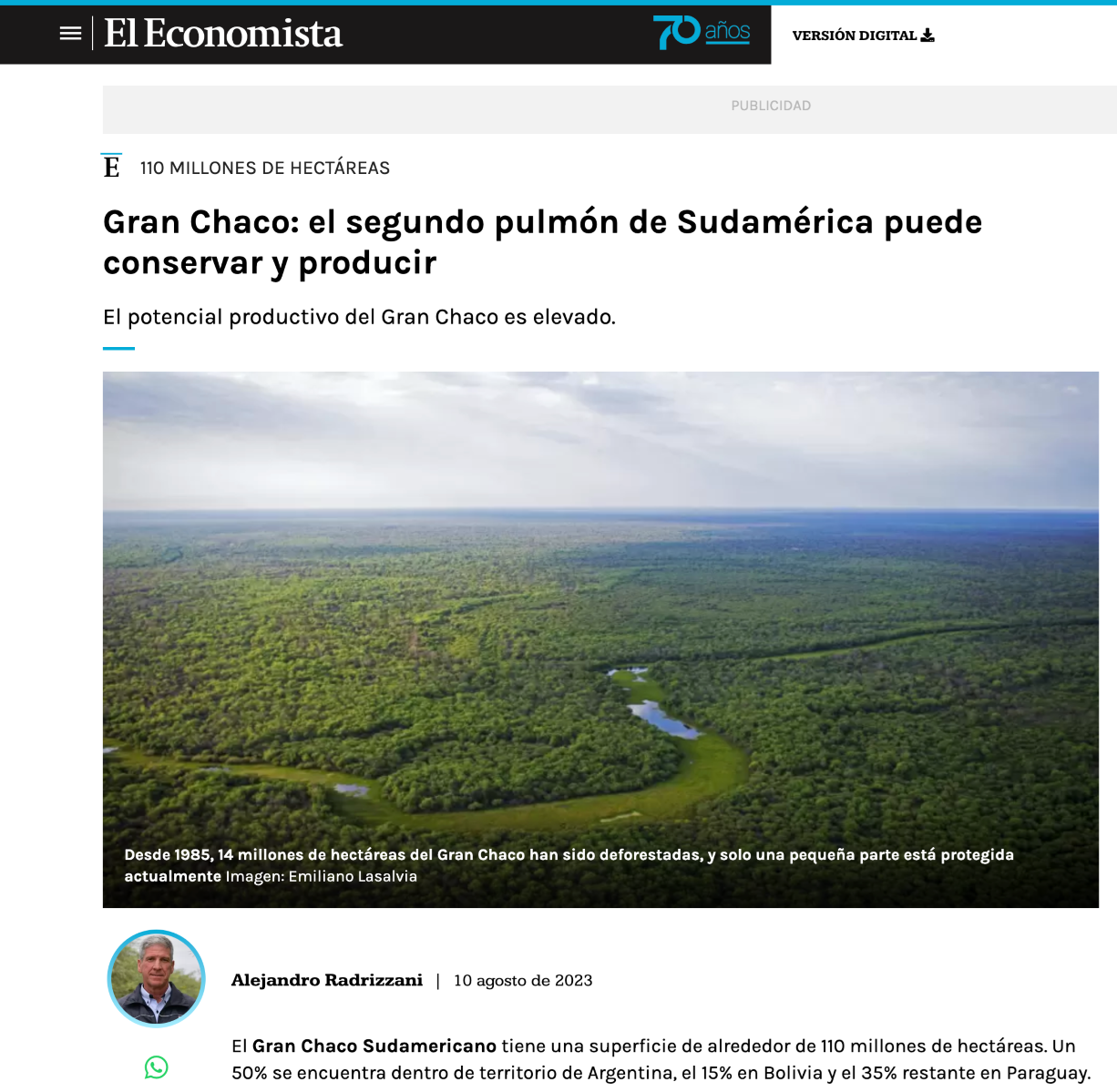110 MILLION HECTARES The productive potential of the Gran Chaco is high. https://eleconomista.com.ar/actualidad/gran-chaco-segundo-pulmon-sudamerica-puede-conservar-producir-n65126

Despite substantial deforestation due to agricultural expansion, the proportion of forests influenced by small-scale producers remained largely stable until 2015, but the number of producers decreased. In the Argentine Chaco, for instance, family farms dwindled drastically in the late 1990s and the 2000s, with the highest disappearance rate between 2005 and 2010, especially in provinces like Santiago del Estero, Chaco, and Formosa. Overall, more small-scale producers were found in areas with low deforestation rates and high forest cover. Active deforestation frontier areas had a higher proportion of disappearing producers. However, despite the growing ecological marginalization of small-scale producers in the Argentine Chaco, they remain widespread and still influence half of the remaining forests. Although they can exert considerable pressure on the forests around their homes, their activities rarely lead to total land-use change. The forest loss driven by small-scale owners is limited to the immediate vicinity of their houses and is small compared to deforestation due to large-scale agricultural commodity expansion in their broader surroundings. In other words, supporting the persistence of family producers in the Gran Chaco indirectly protects its forests.
Fontagro project financed by the Ministry for Primary Industries of New Zealand, by the Global Research Alliace (GRA)
Agriculture in this vast region inevitably requires clearing forest cover and has displaced livestock farming onto pastures, which, in turn, encroached upon forested areas. Traditionally, livestock use in forests has been resolved through extensive livestock farming or clearing and planting pastures, maintaining a sparse woody cover comprising non-regenerating adult trees. However, more sustainable livestock farming can be achieved by selectively thinning trees and removing shrubs, leaving larger trees intact. In the Gran Chaco region, silvopastoral systems (SPS) in mixed native forests and degraded savannas are being designed to specifically address the problem associated with dense shrub thickets and overstocked secondary forests caused by livestock overgrazing, over logging, changes in the fire regime, and fencing.
"In the last few decades, there has been rapid expansion and intensification of agricultural and livestock production in the South American Chaco region. In this context, the aim is to improve the efficiency, stability, and resilience of family livestock systems in the Chaco region, incorporating alternative technologies for management and livestock handling. Researchers, extension workers, and producers from the three countries sharing the South American Chaco - Argentina (INTA-ArgenINTA), Bolivia (INIAF and FeGaSaCruz), and Paraguay (IPTA-IICA) - are involved," says Eugenia Saini, Executive Secretary of Fontagro.
The project's central proposal is based on adopting and combining low-impact environmental technologies, striking a balance between system productivity, integrity, and services while maintaining and improving the well-being of family producers and associated communities. SPS are established using a mechanical treatment called "low intensity roller-chopping" and the planting of mega-thermal pastures, which enhances system productivity while preserving biodiversity, soil properties, and early tree regeneration. The project identified the main limitations of these producers, including inadequate forage reserves; improper adjustment of stocking rates and grazing management; the existence of degraded pastures; deficient breeding management strategies; lack of planning for services; poor management of replacement heifers; health issues like inadequate control of infectious diseases causing abortion or postpartum death, and poor control of internal and external parasites. Infrastructure, capital and financing shortages, lack of animal drinking water access, inadequate operation planning and management, and the need for technical advice also pose challenges. The project is based on 90 pilot production systems where proposed technologies are implemented to overcome these limitations. Around them, learning environments and experience sharing between producers, extension workers, researchers, and private advisors are created. So far, a total of 103 group training instances have been conducted involving 2,467 livestock producers from the 3 participating countries. Initial results are already visible.
A clear conclusion is that reducing deforestation and greenhouse gas emissions in the Gran Chaco region can be achieved through increased livestock productivity, in tandem with sustainable development and improved quality of life for local communities. Integrated policies and strategies, along with the participation and collaboration of diverse stakeholders, are essential to achieve a more sustainable approach in all economic activities in the region.
References
Levers, C.; Romero-muñoz, A.; Baumann, M.; De Marzo, T. Agricultural expansion and the ecological marginalization of forestdependent people. Proc. Natl. Acad. Sci. USA 2021, 118, e2100436118. https://doi.org/10.1073/pnas.2100436118
Peri, P. L., Rosas, Y. M., López, D. R., Lencinas, M. V., Cavallero, L., & Martínez Pastur, G. (2022). Marco conceptual para definir estrategias de manejo en sistemas silvopastoriles para los bosques nativos. Ecología Austral, 32(2bis), 749-766. https://doi.org/10.25260/EA.22.32.2.1.1872Referencias
Levers, C.; Romero-muñoz, A.; Baumann, M.; De Marzo, T. Agricultural expansion and the ecological marginalization of forestdependent people. Proc. Natl. Acad. Sci. USA 2021, 118, e2100436118. https://doi.org/10.1073/pnas.2100436118
Peri, P. L., Rosas, Y. M., López, D. R., Lencinas, M. V., Cavallero, L., & Martínez Pastur, G. (2022). Marco conceptual para definir estrategias de manejo en sistemas silvopastoriles para los bosques nativos. Ecología Austral, 32(2bis), 749-766. https://doi.org/10.25260/EA.22.32.2.1.1872




